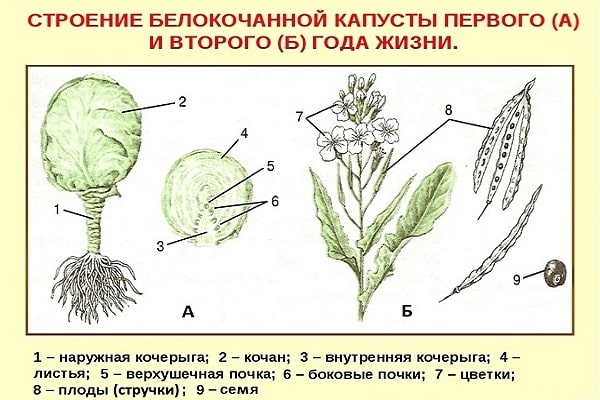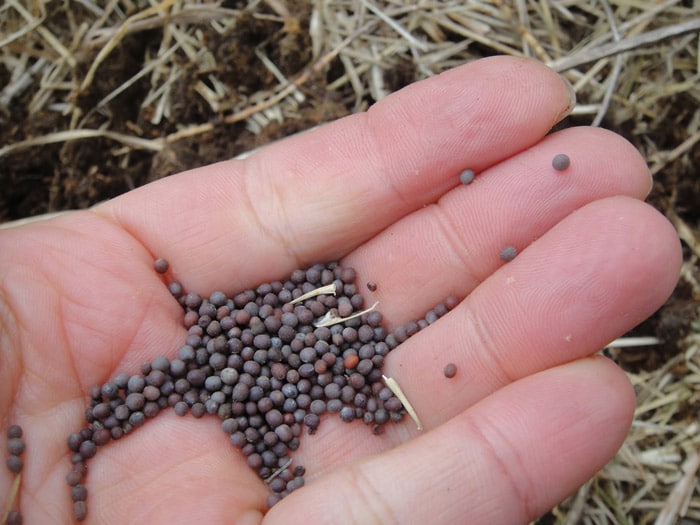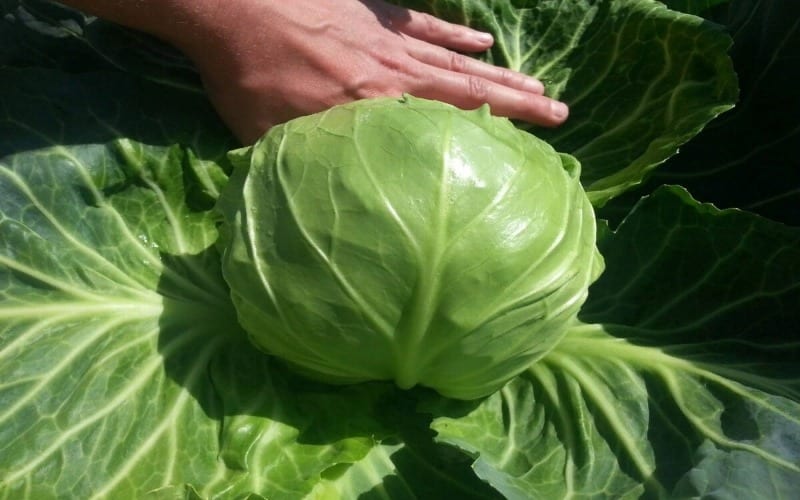How to get cabbage seeds
Producing cabbage seeds independently allows gardeners to save money, preserve rare crop varieties, and grow plants already adapted to the natural conditions of the region. The quality of the harvest depends on the seeds - if they are obtained independently, the summer resident can be 100% confident in the results of his work.
How to get cabbage seeds at home
White cabbage belongs to the cruciferous family, has a growing season of 2 years and is propagated by seeds.
Seed material can be obtained from pods formed in the second year of the plant’s life on shoots with peduncles. Self-harvesting seeds allows gardeners to grow high-quality cabbage.
Where do cabbage seeds come from?

From a biological point of view, cabbage externally represents an overgrown apical bud, which contains nutritional components.
In the second year of life, a shoot with peduncles is formed in its place, which can reach a length of 1.5 m or more. The result of flowering, which occurs over 2-4 weeks, is the formation of cabbage fruits - pods 8-10 cm long with 20-26 brown seeds.
Attention! Some varieties of vegetables produce arrows in the first year. However, such material will be of poor quality and unripe, which will negatively affect the harvest.
You cannot get grain if a hybrid was initially planted. It is impossible to achieve germination in this case.
How are white cabbage seeds formed?
Seeds for cabbage planting are formed from mother plants, which gardeners select in the fall or late summer. They are stored in the winter, and in the spring they are again placed in the ground, where they produce shoots with flower stalks. After this, the queen cells are called testes.
For seed formation, it is better to use late and mid-late cabbage varieties that tolerate wintering well.
Experienced gardeners identify and prepare in advance the plants that are grown in queen cells:
- Early varieties The seeds are sown later than the traditional dates - in May or early June, with transfer to open soil in July.
- Late ripening And mid-late varieties, on the contrary, are planted early so that they can ripen before autumn frosts.
- When growing, a small amount of nitrogen fertilizer is applied, which will help to better withstand the winter.
- The best fruits are selected from the grown fruits - healthy ones, without damage or damage by microorganisms.
The crop is taken out of the ground with its roots and the rosette leaves are removed with a clean blade, leaving 2-3 tightly adjacent to the head of cabbage. The procedure must be carried out before the first frost.
The key to obtaining good seed material is the correct selection of queen cells with certain characteristics.
Preference is given to fruits:
- low-growing with a thin stump, a large head, a small number of outer leaves, and short petioles;
- preserving the characteristics of the variety as much as possible;
- healthy, without damage or damage from pathogenic flora;
- flat if flat-round varieties are used to obtain seeds.
For bushes that are used as queen cells for seed production, a separate area is allocated. Plant the seeds immediately in open ground so that the root system strengthens and adapts to long-term storage.
How to collect them

The testes are removed as they ripen, when the pods become yellowish in color and the seeds in them become brownish. Peduncles are broken off, connected into small bunches and hung root up in a warm and dry room until fully ripened. They should not touch, so if there are a large number of queen cells, it is advisable to distribute them on wooden lattice racks, ensuring air flow.
Attention! It is recommended to place a cloth or paper under the hanging seeds to collect the fallen grains.
When the pods are completely dry, they are separated from the stems. The seeds are carefully removed. Cabbage grains are tender; they are threshed delicately and winnowed, removing husks and debris. One testis produces 25-150 g of seed material. From one harvest you can prepare grains for 3-4 years.
How to store it correctly
In order for the seed to produce a good harvest, it is important to properly store not only the seeds already obtained, but also the queen cells. The optimal room temperature is 0...+1°C, humidity is 80-85% (to prevent the development of gray rot).
When the temperature increases to +6...+8°C, metabolic processes in the queen cell do not stop, and the process of formation of generative organs does not occur. That is, a crop in open ground will produce a lot of green foliage instead of shoots, which is not suitable for obtaining seeds. Raise the temperature only a month before the planned planting (up to +5°C).
When storing queen cells, it is important to follow the recommendations:
- dip the root in the liquid clay mixture and let dry;
- sprinkle the stump and leaves with crushed chalk (from rot);
- keep queen cells separate from vegetables intended for consumption;
- Give the cabbage complete rest (do not shift or peel).
After receiving the seeds, they are inspected and damaged ones are removed. The seed material is placed in paper or fabric bags. The shelf life of the grains is 3-4 years.
How to grow cabbage seeds yourself

Mid-ripening and late-ripening varieties of cabbage are better suited for obtaining seeds.
Algorithm:
- Select suitable heads of cabbage.
- Ensure optimal storage conditions after removal from the soil.
- Prepare overwintered vegetables for planting.
- Plant the stalks in the ground.
- Provide testis care.
- Collect ripe pods in time.
- Carefully remove the seed.
Landing

The stumps are transferred to the ground at the end of April - beginning of May, depending on the region. A month before, each queen cell is carefully inspected - rotten roots and leaves are removed. The head of cabbage (if the vegetable is left in this form) is cut to form a cone narrowed at the top with a base diameter of up to 20 cm.
15-20 days before planting, the stumps are distributed in stacks in the open air (roots inward). Each layer is generously covered with humus and watered with manure diluted with water. This will ensure the active development of the stumps, but you need to monitor the temperature level so that the roots do not freeze.
Attention! An area where cruciferous crops have not been grown in the previous 3-4 years is suitable for planting.
Fertilize the area in the fall using manure (6 kg per 1 m²). In spring, the plants are fed with potash (10 g/m²) and phosphate fertilizers (20 g/m²), and the area is dug up.
Landing is carried out according to the following algorithm:
- Dig holes at a distance of 50 cm in the row. Row spacing is 70 cm.
- Pour 300 g of humus and 20-25 g of phosphates into each hole. Mix with soil.
- In a separate bowl, prepare a solution of clay and liquid mullein.Dip the root of each stump into the composition before planting.
- Place the plant in a hole at a slight slope, add soil and compact it around the roots. Plant a little deeper than the rooting was in the first year.
- Water the hole and loosen the soil.
If cabbage grows nearby (for example, from neighbors), the risk of cross-pollination is high. Then a piece of gauze is put on each head of cabbage, fixing the stalk at the base.
However, this algorithm for growing queen cells is effective only for late-ripening and mid-late varieties.
To obtain seeds from early varieties, they act differently:
- Cut the stalk from the selected heads, removing even the covering foliage.
- Place the fruits in the cellar for storage.
- In autumn, pour fertilized soil into pots and place stalks. Regularly water with warm water (+20…+22°C), loosen the soil.
- Store in the basement with queen cells of late varieties under the same conditions.
- With the onset of planting time (April-May), the crop is transferred to the garden bed along with a lump of earth.
This planting algorithm strengthens the root system of early varieties of queen cells. This is beneficial for cultural adaptation and sustainability to diseases after disembarkation. The method is especially suitable for the northern regions of central Russia with long winters.
Care

After planting, the seed plants require special care. If there is a risk of frost in the first week, cover the beds with a layer of straw, which will save heat. During this period, the seedlings will adapt and the insulation can be removed.
Water the plantings regularly as the soil at the base of the stump dries out. The frequency is determined by regional climatic conditions - approximately once every 7-10 days. In hot weather, moisturizing is carried out more often.Water the crop in the evening with settled water heated in the sun. The soil is periodically loosened.
2 weeks after planting, cabbage is fertilized for the first time with mullein solution, consumption - 3 liters per bush. The second fertilizing is applied immediately before the plant blooms. Nitrogen fertilizers (nitrophoska) are suitable, consumption - 25 g per 1 m².
Crop care activities also include:
- Removing old foliage. The leaves with which the plant survived the winter are removed 2 weeks after being transferred to the ground. If you do not carry out the procedure, the plant will rot.
- Garter bushes. When an arrow appears, it is immediately tied to a peg fixed on the ground. This will prevent the stems from breaking.
- Removing unnecessary parts of the bush. Excessively large shoots are removed. Excess stems are also removed, leaving only strong and healthy ones.
Cabbage flowering lasts 25-30 days. Next, pods with seeds are formed on the crop, which ripen for another 50 days.
Conclusion
Growing cabbage seeds yourself is not difficult if you follow the recommendations given. The main thing is to select suitable mother plants, provide them with the right wintering conditions, and follow the rules of planting and care.
Procuring seed material will allow you to avoid purchasing low-quality seeds, select already proven varieties and, as a result, get a good harvest.